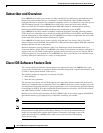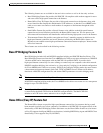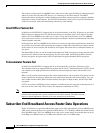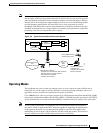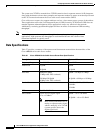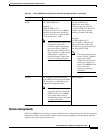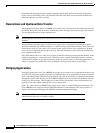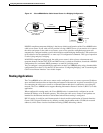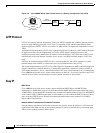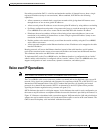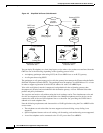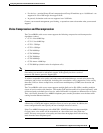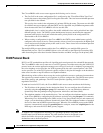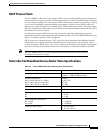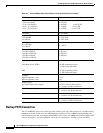
Configuring Subscriber-End Broadband Access Router Features
Subscriber-End Broadband Access Router Data Operations
MC-615
Cisco IOS Multiservice Applications Configuration Guide
Figure 111 Cisco uBR900 Series Cable Access Router in a Bridging Configuration
DOCSIS-compliant transparent bridging is the factory default configuration of the Cisco uBR900 series
cable access router. If your cable service provider is using a DHCP server, all you need to do is connect
the cables and power on the cable access router; your service provider configuration program will
automatically configure both the coaxial cable interface and the bridging functionality. You need not set
up IP addresses for the attached PCs or enter any CLI configuration commands. This type of operation
is called “plug-and-play” bridging.
In DOCSIS-compliant bridging mode, the cable access router is able to locate a downstream and
upstream channel; find the ToD, TFTP, and DHCP server(s); obtain an IP address; download a DOCSIS
configuration file; and obtain DHCP parameters to work in a bridging mode.
You can configure a customized bridging application on the Cisco uBR900 series using a downloadable
configuration file or the CLI. For details, see the sections “Configuring Bridging” and “Customizing the
Cable Access Router Interface” later in this chapter.
Routing Applications
The Cisco uBR900 series cable access router can be configured to act as a router to preserve IP address
space and limit broadcasts that can impact the performance of the network. A typical use would be if you
are connecting the cable access router to an internal Ethernet hub that is connected to an existing PC
network. The Cisco uBR900 series supports Routing Information Protocol Version 2 (RIP V2) for this
application.
When configured in routing mode, the Cisco uBR900 series is automatically configured to use the
headend IP address as its IP default gateway. This allows the cable access router to send packets not
intended for the Ethernet interface to the headend when IP host-routing is configured.
RIP V2 routing is useful for small internetworks in that it enables optimization of Network Interface
Center (NIC)-assigned IP addresses by defining variable-length subnet masks (VLSMs) for network
addresses, and it allows classless interdomain routing (CIDR) addressing schema.
Cisco uBR7200 series
CMTS
CATV
coaxial cable
HFC network
Cisco uBR900 series
cable access router
Ethernet
13305
Ethernet
Ethernet
Ethernet
PC
PC
PC or hub
PC




